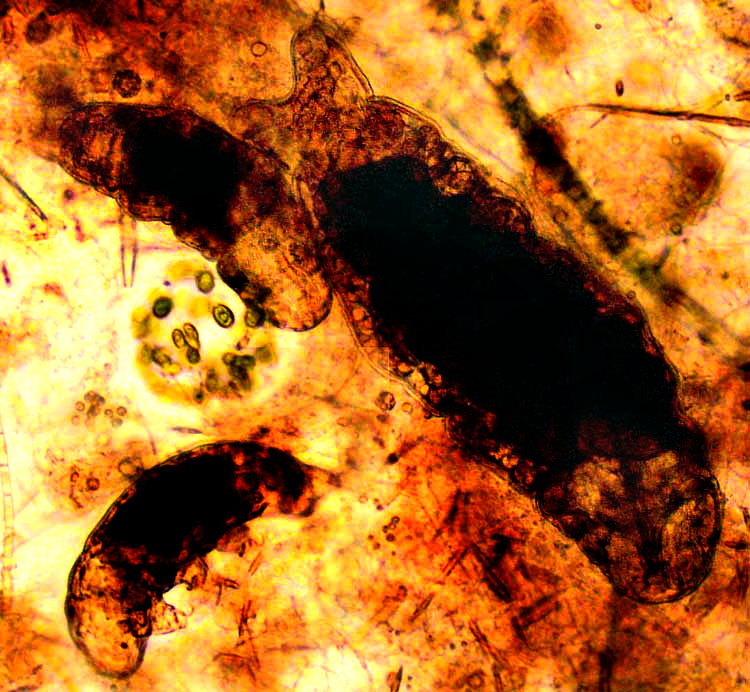Excerpts from Jim Conrad's
Naturalist Newsletter

from the February 24, 2013 Newsletter issued from the valley of the Dry Frio River in northern Uvalde County, southwestern Texas, on the southern border of the Edwards Plateau; elevation ~1750m (~5750 ft); N29.62°, W99.86°; USA
WATER BEARS
During this week's microscopic expedition into a drop of water from the little Dry Frio River behind the cabin I came to a part of the slide upon which a diffuse gob of mushy, decaying plant material lay, in which were found the slow-moving critters shown above.
Compared to other organisms on the slide, these were fairly large, seen here at my lowest magnification. The largest of the three shown is about one millimeter long (3/32nd inch). Keeping in mind that we're looking down on the tops of the two individuals at the top of the image, notice that the largest one's rear end is deeply divided. The small one in the picture's lower left is on its side, showing leg-like structures on its belly side. In short, these tiny creatures appear to be structured very much like the thumb-sized, juicy caterpillars found in the summer munching on tree leaves or garden tomato plants. Could such small, aquatic organisms be the caterpillar stage of an insect?
I'm glad I didn't have to wrestle with that question because I might have wasted lots of time trying to figure out which insect species produce such caterpillars. Instead, because they're so unlike the daphnia, rotifers and other microorganisms we usually see, and because they have such a cute name, I remembered from my student days that these little beings are called water bears or sometimes moss piglets. More technically they're referred to as tardigrades.*
That's interesting because all by themselves tardigrades constitute a whole phylum of the Animal Kingdom. Phyla are top-level taxonomic divisions right below kingdom, so we're dealing with a whole other kind of animal than normally we see or hear about. Our little water bears have nothing to do with insect caterpillars. Despite their uniqueness, water bears are exceedingly common, occurring in many marine, freshwater, and semiaquatic terrestrial environments worldwide. In the submerged, decaying vegetative ooze ours inhabited they were doing the job of breaking down organic matter into simpler components to be made available to less complex organisms.
Science finds tardigrades especially interesting because as a group they are one of the most complex of all known organisms known as "polyextremophiles." Extremophiles, without the "poly" prefix, are organisms capable of thriving in extreme physical and/or chemical conditions. Polyextremophile are extremophiles that can thrive in a much greater variety of extreme conditions. For example, certain tardigrades can withstand temperatures ranging from just above absolute zero to well above the boiling point of water. They can survive pressures greater than that in the deepest ocean trenches and have survived the vacuum of outer space. They survive solar radiation, gamma radiation and ionic radiation at doses hundreds of times higher than would kill a human. They can go without food or water for nearly 10 years, drying to the point where they are 3% or less water, but then rehydrate, forage, and reproduce.
Something else curious about tardigrades is that they are "eutelic," which means that all adult tardigrades of the same species possess the same number of cells. Some species have as many as 40,000 cells in each adult, while others have far fewer.
To me it seems that tardigrades are so exotic that they might as well be from some other planet. However, they've been on Earth for a long time, with fossils showing up from the Cambrian of some 500,000,000 years ago. In fact, some specialists regard tardigrades as ancestors of arthropods, which includes everything from insects and spiders to shrimp and barnacles. In a sense, then, when we see water bears lumbering across stems of aquatic milfoil, we're witnessing a scene from the distant, distant past.